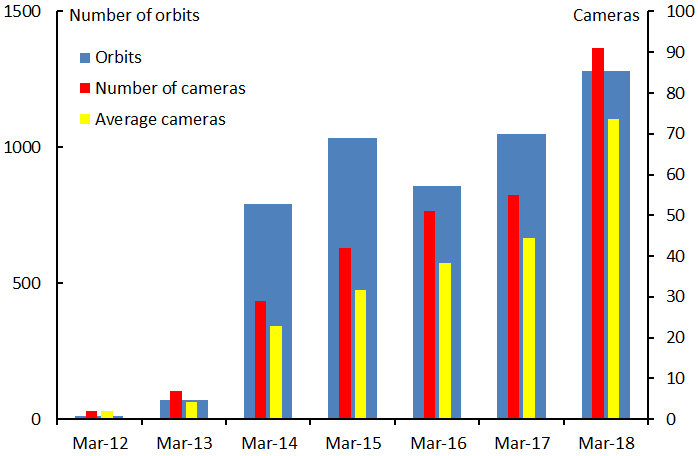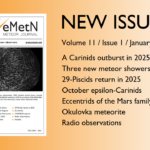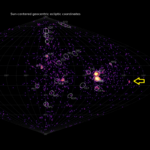A summary of the activity of the CAMS BeNeLux network during the month of March 2018 is presented. The weather was neither exceptional good nor bad, but a bit less favorable than March in previous years. 9324 meteors were recorded, 3391 of which proved multiple station, or 36%. In total 1280 orbits were collected during this month.
1 Introduction
After an exceptional successful month of February the weather returned to a more normal situation for the low lands of the BeNeLux. March 2018 became an average month with rather less good circumstances than what March brought previous few years. Nights are getting shorter and meteor activity declines.
2 March 2018 statistics
CAMS BeNeLux managed to collect 9324 meteors of which 3391 or 36% were multi-station meteors good for 1280 orbits. This is the best number of orbits for the month of March ever. The statistics of March 2018 are compared in Figure 1 and Table 1 with the same month in previous years since the start of CAMS BeNeLux in 2012.
As many as 91 cameras were active during one of the best nights of March 2018. On average 73.5 cameras were capturing per night. 6 nights did not yield any orbit, but even during these nights some meteors were registered. Thanks to AutoCAMS the surveillance of the BeNeLux sky was guaranteed with a minimum of 53 active cameras on all nights. On as many as 25 nights orbits have been collected. Figure 1 shows the enormous increase in camera capacity. Using many more cameras than previous years helped to collect more orbits than during any previous month of March, compensating the less favorable weather in March 2018.
Some technical problems at some CAMS stations prevented the identification of simultaneous meteors. A problem occurred with the time synchronization in the CAMS network. The software used to keep the CAMS PC’s clocks synchronized; Dimension4 caused some very large errors on the time registration which depended on the settings of this software at some stations. By the time the problem was noticed, a lot of double station meteors had been lost due to invalid timing.
One of the basic CAMS Stations of the network, Oostkapelle, with 8 cameras, was temporarily shut down for renovation works which will take several months. This and the time synchronization problems at some CAMS stations meant that the network didn’t run at full capacity during this month.

Figure 1 – Comparing March 2018 to previous months of March in the CAMS BeNeLux history. The blue bars represent the number of orbits, the red bars the maximum number of cameras running in a single night and the yellow bar the average number of cameras running per night.
Table 1 – March 2018 compared to previous months of March.
| Year | Nights | Orbits | Stations | Max. Cams | Min Camas | Mean Cams |
| 2012 | 2 | 12 | 2 | 2 | 2.0 | |
| 2013 | 10 | 69 | 6 | 7 | 4.2 | |
| 2014 | 24 | 793 | 12 | 29 | 22.8 | |
| 2015 | 23 | 1033 | 14 | 42 | 31.7 | |
| 2016 | 23 | 856 | 16 | 51 | 12 | 38.2 |
| 2017 | 26 | 1048 | 19 | 55 | 20 | 44.4 |
| 2018 | 25 | 1280 | 22 | 91 | 53 | 73.5 |
In the night of 11-12 March a number of orbits caught attention and an analyses was made to find more information about the associated minor shower, the X Herculids (346-XHE) (Roggemans and Campell-Burns, 2018).
The best memory of March 2018 remains beyond doubt the annual CAMS-meeting in Bussloo, the Netherlands which took place on 11 March (Roggemans, 2018).
3 Conclusion
March 2018 brought back the usual weather for the BeNeLux with mainly overcast sky and only few clear nights. Thanks to the many extra cameras compared to previous years more orbits were collected than any previous month of March.
Acknowledgment
Many thanks to all participants in the CAMS BeNeLux network for their dedicated efforts. Thanks to Carl Johannink for providing all the data on which this report is based. The CAMS BeNeLux team is operated by the following volunteers:
Hans Betlem (Leiden, CAMS 371, 372 and 373), Felix Bettonvil (Utrecht, CAMS 376 and 377) , Jean-Marie Biets (Wilderen, CAMS 380, 381 and 382), Martin Breukers (Hengelo, CAMS 320, 321, 322, 323, 324, 325, 326 and 327), Bart Dessoy (Zoersel, CAMS 397, 398, 804, 805 and 806), Franky Dubois (Langemark, CAMS 386), Luc Gobin (Mechelen, CAMS 390, 391, 807 and 808), Robert Haas (Alphen aan de Rijn, CAMS 3160, 3161, 3162, 3163, 3164, 3165, 3166 and 3167), Robert Haas / Edwin van Dijk (Burlage, CAMS 801, 802, 821 and 822), Klaas Jobse (Oostkapelle, CAMS 330, 331, 332, 333, 334, 337, 338 and 339) , Carl Johannink (Gronau, CAMS 311, 312, 313, 314, 315, 316, 317 and 318), Hervé Lamy (Dourbes / Ukkel, CAMS 394 and 395/ 393), Koen Miskotte (Ermelo, CAMS 351, 352, 353 and 354), Piet Neels (Ooltgensplaat, CAMS 340, 341, 342, 343, 344 and 345, 349, 840), Tim Polfliet (Gent, CAMS 396), Steve Rau (Zillebeke, CAMS 385 and 387), Paul Roggemans (Mechelen, CAMS 383, 384, 388, 389, 399 and 809), Hans Schremmer (Niederkruechten, CAMS 803) and Erwin van Ballegoij (CAMS 347 and 348).
References
Roggemans P. and Cambell-Burns P. (2018a). “x Herculids (XHE-346)”. eMetN, 3, 120–127.
Roggemans P. (2018). “CAMS meeting 11 March 2018”. eMetN, 3, 108–113.




